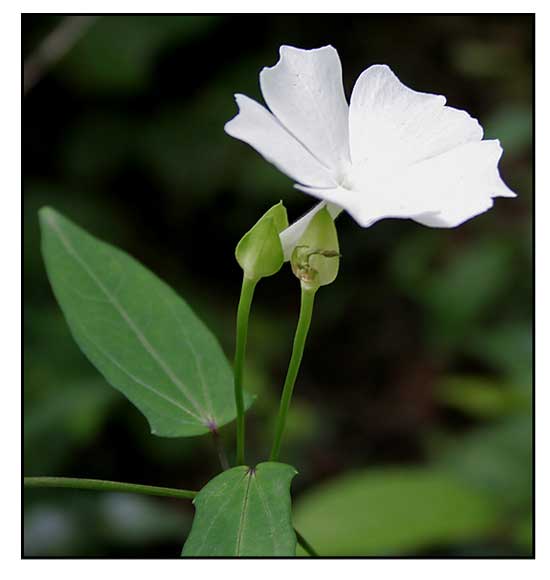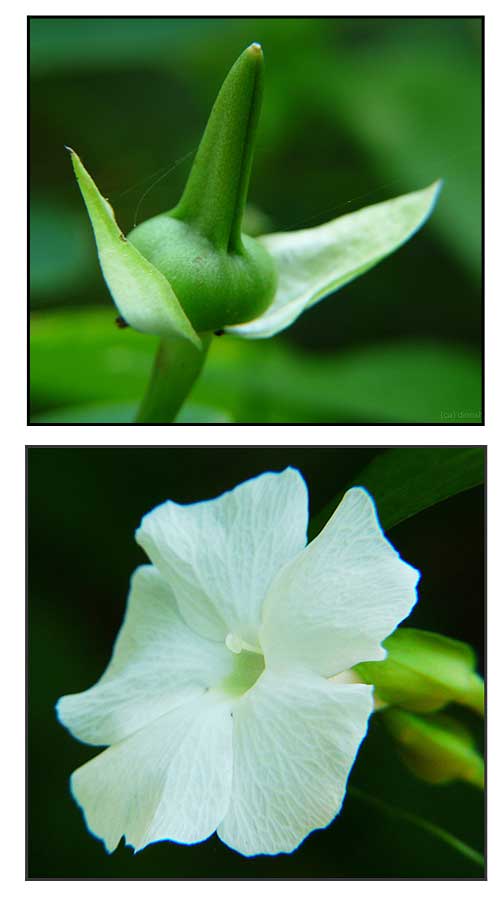
Family • Acanthaceae
White lady
Thunbergia fragrans Roxb.
FRAGRANT THUNBERGIA / SWEET CLOCKVINE
Wan hua cao
| Scientific names | Common names |
| Myenia longiflora Benth. ex Hohen. | Angel wings (Engl.) |
| Thunbergia angustifolia Buch.-Ham. ex Nees | Fragrant thunbergia (Engl.) |
| Thunbergia bodinieri H.Lév. | Thunbergia white gem (Engl.) |
| Thunbergia cordata Colla | Sweet clockvine (Engl.) |
| Thunbergia fragrans Roxb. | White clockvine (Engl.) |
| T. fragrans subsp. hainanensis (C.Y.Wu & H.S.Lo) H.P.Tsui | White lady (Engl.) |
| Thunbergia fragrans var. heterophylla C.B.Clarke | White thunbergia (Engl.) |
| Thunbergia fragrans f. javanica C.B.Clarke | |
| T. fragrans hainanensis C.Y.Wu & H.S.Lo | |
| Thunbergia heterophylla Wall. | |
| Thunbergia java Hoffmanns. | |
| Thunbergia linearifolia Bremek. | |
| Thunbergia loheri Bremek. | |
| Thunbergia longiflora F.Muell. | |
| Thunbergia mindanaensis Bremek. | |
| Thunbergia roxburghia Nees | |
| Thunbergia scandens Pers. ex Nees | |
| Thunbergia subsagittata Blanco | |
| Thunbergia volubilis Pers. | |
| Roxburghia rostata Russell ex Nees | |
| Thunbergia fragrans Roxb. is an accepted species. KEW: Plants of the World Online | |
| Other vernacular names |
| CHINA : Wan hua cao. |
| FINNISH: Karhunköynnos, Tuoksususanna. |
| FRENCH: Dame blanche, Liane de chine. |
| GERMAN: Schwarzäugige. |
| INDIA: Chimin phool (Asssamese), Chimine (Haryanvi, Hindi), Hegala balli, Indrapushpa (Kannada), Noorvan valli (Malayalam), Chimani, Chimine (Marathi), Zawnga-fian-parvar (Mizo), Chakrakedar (Odia), Intrapushpi, Kaasa nangai, Thanni kodi, Vellai chedi (Tamil), Indrathige, Palathiga (Telugu), Pugelu ballu (Tulu). |
| PORTUGUESE: Tumbergia branca, Guaco. |
| SPANISH: Susana blanca, Flor de nieve. |
| SWEDISH: Vit thunbergia. |
| OTHERS: Indrapushapa (Siddha). |
Distribution
Properties Availability |
October 2025
![]()
 |
| Â Â Â Â Â Â Â Â Â Â Â Â Â Â Â Â Â Â Â Â Â Â Â Â Â PHOTOS / ILLUSTRATIONS |
| IMAGE SOURCE: Chimine: Thunbergia fragrans / J M Garg / CC BY-SA 4.0 / Click on image or link to go to source page / Wikipedia |
| IOTHER MAGE SOURCE: Sweet clockvine: Thunbergia fragrans / © dineshvalke / Some rights reserved / CC BY-SA 4.0 International Deed / Click on image or link to go to source page / iNaturalist |
| IOTHER MAGE SOURCE: Sweet clockvine: Thunbergia fragrans / © dineshvalke / Some rights reserved / CC BY-SA 4.0 International Deed / Click on image or link to go to source page / iNaturalist |
| Photos © Godofredo Stuart / StuartXchange |
| IMAGE SOURCE: Hedyotis costata / Subject Database of China Plant <http://www.naturemuseum.net/album/ShowPhoto.aspx?photoid=2671c974-77ca-44f9-b304-0f16660a06f7> Helixcn |
| OTHER IMAGE SOURCE: /Gliricidia sepium (Jacq.) Kunth ex Walp. - quickstick GLSE2 / Steve Hurst @ USDA-NRCS PLANTS Database / USDA |
| OTHER IMAGE SOURCE: / File:Fruit of Syzygium samarangense / Wax apple / Plate from book / Flora de Filipinas / Francisco Manuel Blanco (OSA) / Public Domain / Wikimedia Commons |
| IMAGE SOURCE: / Photos (2) / Pterocaulon redolens (Willd.) F.-Vill. / © Collected by www.plant.ac.cn / ZHIWUTONG / CLICK ON IMAGE TO GO TO SOURCE PAGE |
| IMAGE SOURCE: / Line drawing / Pterocaulon redolens (Willd.) F.-Vill. / © Collected by www.plant.ac.cn / ZHIWUTONG / CLICK ON IMAGE TO GO TO SOURCE PAGE |
| IMAGE SOURCE:Phyllantaceae : Flueggea flexuosa / Leaf / Copyright © 2018 by P B Pelser & J F Barcelona (contact: pieter.pelser@canterbury.ac.nz) [ref. DOL131909] / Non-Commercial Use / Image modified / Click on image or link to go to source page / Phytoimages.siu.edu |
| OTHER IMAGE SOURCE: / Flower close-up / dracobotanicus -- Wayne Dumbleton / Creative Commons Attribution / flickr / Click on graphic to see original image / flickr |
| OTHER IMAGE SOURCE: Mexican tea / Dysphania ambrosioides / © J Richard Abbott / Some rights reserved / NC BY-NC / Click on image or link to go to source page / iNaturalist |
| OTHER IMAGE SOURCE: / Illustration / Cissampelos pareira L. [5809-247450-161657] / Indian medicinal plants, vol. 1: t. 42 / PlantIllustrations.org |
| ebay |
| IMAGE SOURCE: Pterocaulon redolens (Willd.) F.-Vill. / © Collected by www.plant.ac.cn / ZHIWUTONG / CLICK ON IMAGE TO GO TO SOURCE PAGE / iNaturalist |
| flickr |
| iNaturalistUK |
| IMAGE SOURCE: Erythrina fusca (Ngatae fisi) / Tau'olunga / CC BY-SA 3.0 / Click on image or link to go to source page / Wikipedia |
| Pacific Island Ecosystems at Risk (PIER) |
| Photos ©Godofredo Stuart / StuartXchange |
| Content © Godofredo Stuart / StuartXchange |
| Content / Photos © Godofredo Stuart / StuartXchange |
| Photos © Godofredo Stuart / StuartXchange |
Additional
Sources and Suggested Readings
|
뱥(5) |
DOI: It is not uncommon for links on studies/sources to change. Copying and pasting the information on the search window or using the DOI (if available) will often redirect to the new link page. (Citing and Using a (DOI) Digital Object Identifier) |
PHOTOS / ILLUSTRATIONS |
| Â Â Â Â Â Â Â Â Â Â Â Â Â Â Â Â Â Â Â Â Â Â Â Â Â Â Â Â Â Â List of Understudied Philippine Medicinal Plants |
| Â Â Â Â Â Â Â Â Â Â Â Â Â Â Â Â Â Â Â Â Â New plant names needed The compilation now numbers over 1,730 medicinal plants. While I believe there are hundreds more that can be added to the collection, they are becoming more difficult to find. If you have a plant to suggest for inclusion, native or introduced, please email the info: scientific name (most helpful), local plant name (if known), any known folkloric medicinal use, and, if possible, a photo. Your help will be greatly appreciated. |
뱥(5) |
 |


 Constituents
Constituents